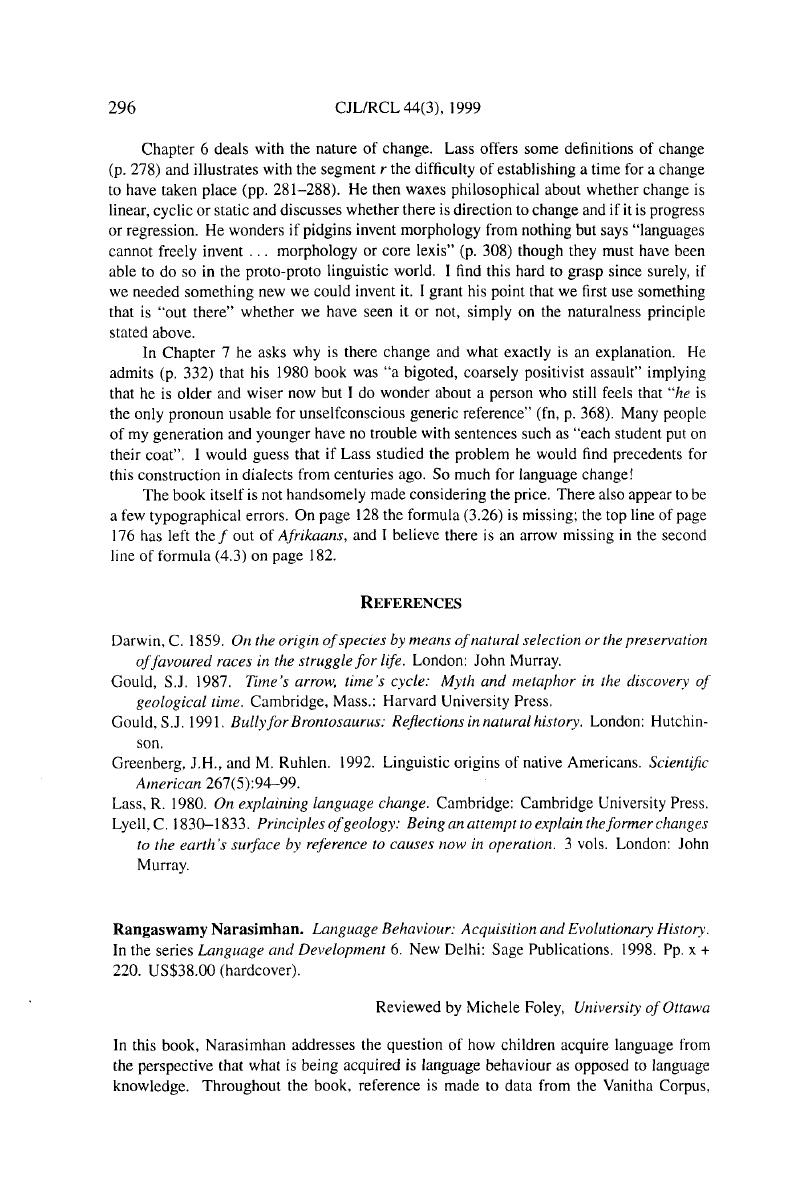No CrossRef data available.
Article contents
Rangaswamy Narasimhan. Language Behaviour: Acquisition and Evolutionary History. In the series Language and Development 6. New Delhi: Sage Publications. 1998. Pp. x + 220. US$38.00 (hardcover).
Published online by Cambridge University Press: 27 June 2016
Abstract
An abstract is not available for this content so a preview has been provided. Please use the Get access link above for information on how to access this content.

- Type
- Reviews/Comptes rendus
- Information
- Canadian Journal of Linguistics/Revue canadienne de linguistique , Volume 44 , Issue 3 , September 1999 , pp. 296 - 299
- Copyright
- Copyright © Canadian Linguistic Association 1999
References
Bickerton, Derek. 1990. Language and species. Chicago: University of Chicago Press.CrossRefGoogle Scholar
Bishop, Dorothy, and Mogford, Kay, eds. 1988. Language development in exceptional circumstances. Edinburgh: Churchill Livingston.Google Scholar
Byrne, Richard. 1995. The thinking ape: Evolutionary origins of intelligence. Oxford: Oxford University Press.CrossRefGoogle Scholar
Cheny, Dorothy L., and Seyfarth, Robert M.. 1990. How monkeys see the world: Inside the mind of another species. Chicago: University of Chicago Press.CrossRefGoogle Scholar
Darwin, Charles. 1965. The expressions of emotions in man and animals. Chicago: Chicago University Press. [1872]Google Scholar
Greenfield, Patricia M., and Savage-Rumbaugh, E. Sue. 1990. Grammatical combination in Pan paniscus: Processes of learning and invention in the evolution and development of language. In Language and intelligence in monkeys and apes, ed. Parker, Sue Taylor and Gibson, Kathleen Rita, 540–578. Cambridge: Cambridge University Press.Google Scholar
Lewis, Morris Michael. 1975. Infant speech: A study of the beginnings of language. 2nd ed. London: Routledge and Kegan Paul. [1936]Google Scholar
MacWhinney, Brian, and Snow, Catherine E.. 1985. The child language data exchange system. Journal of Child Language
12:271–96.Google Scholar
Narasimhan, Rangaswamy. 1981. Modelling language behaviour. Heidelberg: Springer-Verlag.CrossRefGoogle Scholar
Premack, David. 1988. Does a chimpanzee have a theory of mind? Revisited, in Machiavellian intelligence, social expertise and evolution of intelligence in monkeys, apes and humans, ed. Byrne, Richard W. and Whiten, Andrew, 160–179. Oxford: Clarendon Press.Google Scholar
Premack, David, and Woodruff, G.. 1978. Does a chimpanzee have a theory of mind?
Brain and Behavioural Sciences
4:515–526.CrossRefGoogle Scholar
Savage-Rumbaugh, E. Sue, and Lewin, R.. 1994. Kanzi: An ape at the brink of human mind. New York: Wiley.Google Scholar
Savage-Rumbaugh, E. Sue, and Macdonald, K.. 1988. Deception and social manipulation in symbol-using apes. In Machiavellian intelligence: Social expertise and evolution of intelligence in monkeys, ed. Byrne, R. and Whiten, A., 224–237. Oxford: Oxford University Press.Google Scholar
Searchinger, Gene. 1995. Acquiring the human language, playing the language game. Ways of Knowing. Transit Media. Equinox Films, (video recording)Google Scholar


